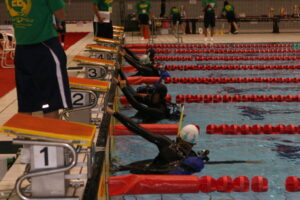
Neil Burgess, President of the Newfoundland & Labrador Shipwreck Restoration Society, was recently interviewed by Jane Adey from CBC TV about the SS Pollux shipwreck and his on-site dive.
The American supply ship Pollux was steaming towards a massive military base in Argentia, Newfoundland, two years into WWII, with a valuable cargo of explosives, radio equipment, aircraft engines, and other materials for the war effort. Two days earlier, it had left Maine and was being escorted by the US destroyers Wilkes and Truxtun. Just the Wilkes made the destination thereof. In a vicious winter storm, the other two ships (Pollux and Truxtun) went down on the jagged rocks off Newfoundland’s south coast. The boats were battered by giant waves and finally broke to bits. The Truxtun was stuck at Chambers Cove and the Pollux at Lawn Point, about one and a half miles west. The Truxtun carried 156 men and the Pollux 233. It was considered one of the worst disasters in US military history. This tragedy is said to have been caused by the combination of rigid adherence to the base course set by naval authorities, a minor miscalculation of the USS Wilkes latitude early in the voyage by its navigator, exceptionally rough weather and strict radio silence. 203 of the 389 officers and enlisted men on board the two ships died.

Although a horrific tale of the sinking of two ships and the loss of 203 officers/crew, it is an account of the immense heroism shown by the people of St. Lawrence and Lawn, who travelled through swirling snow to the wreck sites, spent hours dragging men out of the water, and over icy cliffs, carrying them to a nearby mine, (temporary hospital set-up) and then into their own homes. The rescuers and their families bathed the numb and semi-conscious survivors in warm water and gave them what little clothing and food they had. Because of this, 186 American sailors survived.

Neil Burgess told us this about his dive on the Pollux::
“The USS Pollux ran aground on Lawn Head, which is a very exposed headland on the Burin Peninsula of Newfoundland. Most days the swell makes it impossible to dive on the wreck. We were lucky to be there when the swell was only 1.5 metres, so the surge on the wreck was manageable. The ship has been beaten apart by wave action and only bits and pieces remain on the seafloor. Most of the wreckage is about 15 metres deep. There is little seaweed on the wreck, again due to wave action. We found lots of small pieces of hardware, like padlocks, nuts, bolts, cutlery and pieces of steel plating in the rocky gullies. We also found larger machinery, like parts of a boiler, deck guns, sections of the propeller shafts and steering gear.
A municipal historic area has been designated at the wreck sites in memory of the USS Truxtun and USS Pollux because of geographical, science, environmental and cultural values.
Thanks to Neil Burgess, President of the Newfoundland & Labrador Shipwreck Restoration Society
You Can Follow Neil on Facebook
Read More Scuba Features, Military Base in Canada, Neil Burgess, Newfoundland, Newfoundland & Labrador Shipwreck Restoration Society, Shipwrecks of Newfoundland, USS pollux, USS Truxton, Word War II The Scuba News


